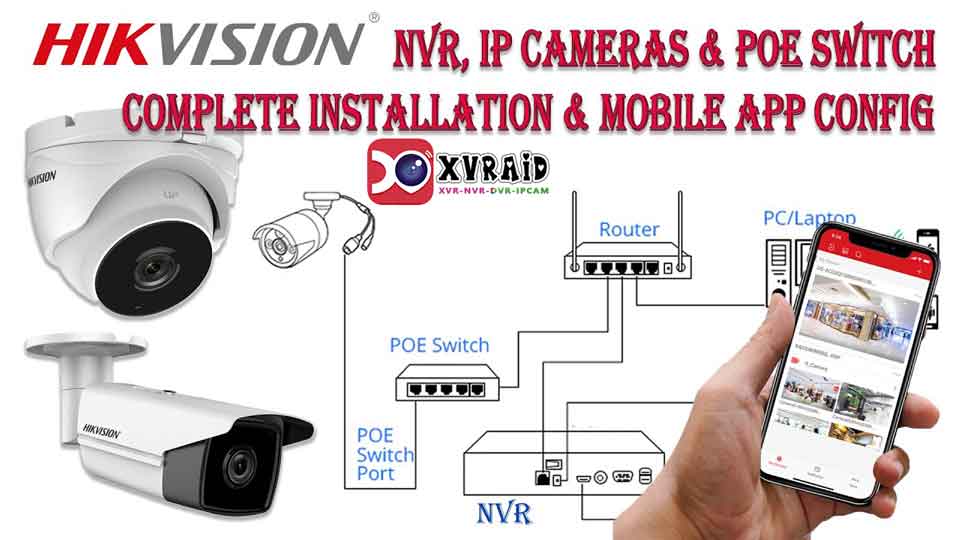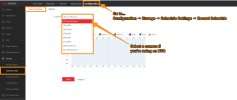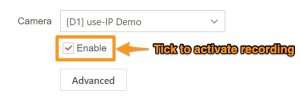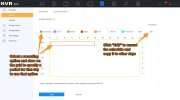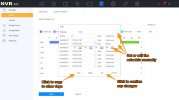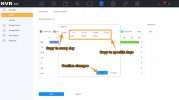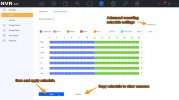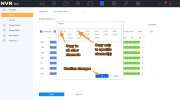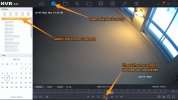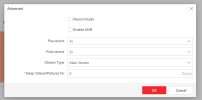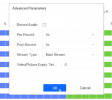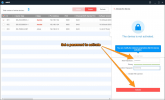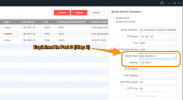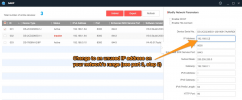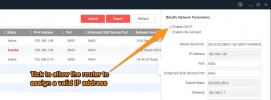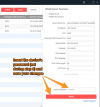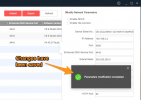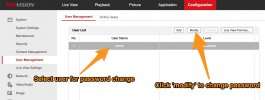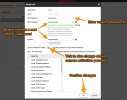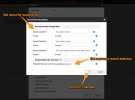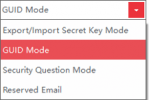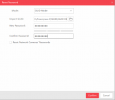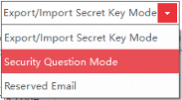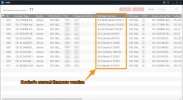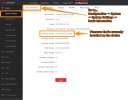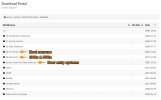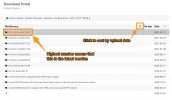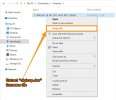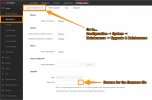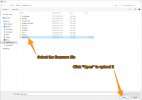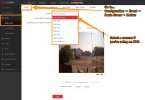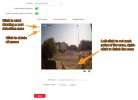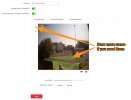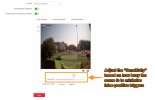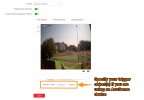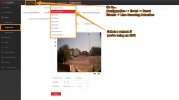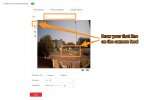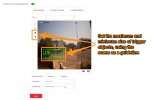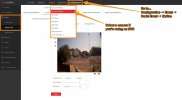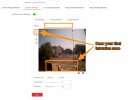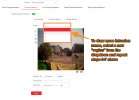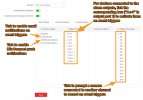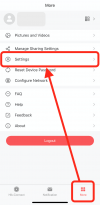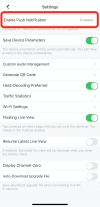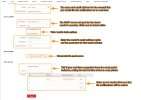Part 5: How do I set up the recording schedule of my Hikvision Device
You will now need to set up your recording schedule to something that suits your needs for each camera, which is key to have set correctly. If it isn’t, you might miss key sections of footage, which could, of course, prove very costly.
There is a range of recording types to choose from. You will need to understand what each means before you begin, these are explained below:
Continuous – The camera will record continuously. If you want the camera to record 24/7, you would fill the grid for the whole week with this option.
Motion – Any time period filled out with this option will only be set to record during instances of motion detection.
Alarm – The camera will only record during instances when an alarm is triggered. This applies to both alarms that you have set up on your IP CCTV system that you have connected to the device’s alarm in ports, such as the VCA Events, or external alarms.
Motion | Alarm – This means that recording will be triggered when either motion detection is triggered, or an alarm device connected to an alarm in port is triggered.
Motion & Alarm – This option just means that the camera will only record when motion detection and a device connected to the alarm in ports are triggered simultaneously.
Event – This is for event-based recording only, so the footage will only be recorded during any VCA event trigger, except motion detection.
POS – This is only supported by I-Series NVRs. You would select this option if you had a “Point of Sale” alarm set up and only want a camera’s footage to be recorded when this is triggered.
Method 1 – In a web browser:
Step 1:
Browse the IP address of the device that will be managing/storing your recordings in an internet browser and log in to it. If you are using an NVR and recording to the onboard hard drives for each camera that’s connected, then this is the device that you will need to log in to.
If your cameras are not connected to an NVR, then you will need to log into the camera directly to set its recording schedule. You will need to use the virtual host feature on your NVR to log into any camera that is connected to its PoE ports, or the camera’s IP address if it is connected to your local network instead.
Step 2:
Navigate to:
Configuration → Storage → Schedule Settings → Record Schedule
You should see your recording schedule in the form of a grid for the week, which is divided into hours.
Select the camera that you want to configure the schedule for from the dropdown menu if on an NVR.
Step 3:
Tick the “Enable” box, which is how you turn the shown schedule on or off:
Step 4:
Now, select the recording option you would like to use for a period from the following options:
Step 5:
Click and drag across the section that of the schedule to which you want to apply the chosen recording option. You can use as many different recording options as you like here.
Step 6:
Finish drawing on the recording schedule for the rest of your week like this.
If you click on a period once it’s drawn, you can see the exact start and end time for it, and more precisely adjust these if need be.
Step 7:
Click “Copy to…” if you would like to use this same schedule for any of your other cameras.
Select these in the popup that appears, and then click “OK”.
…..
Step 8:
Once you’re happy with how your schedule looks, click “Save” to finish and apply the schedule to your camera(s).
Method 2 – In the NVR’s local GUI:
Step 1:
Using the menu at the top of the screen, go to:
Storage → Schedule → Record
You will see your recording schedule as a grid for the week that’s segregated into hours.
Select your camera’s channel from the “Camera No.” dropdown, and then tick the “Enable Schedule” box.
Step 2:
You have a couple of options here for actually establishing your schedule…
Option 1:
Drawing on your schedule is the quickest way.
You will need to click on one of the colour-coded recording options, and then click and drag your mouse across your desired time period to draw your schedule on this timeline.
When you’re done setting up your schedule for the week, click “Apply” to save it. Make sure you have not left any small gaps in the schedule.
Option 2:
Click “Edit” on the right-hand side of your schedule.
This will bring up a window in which you can set your schedule for each day by using the top dropdown.
Ticking “All Day” means that the recording “Type” that you select will be used for the entire day.
Unticking “All Day” will allow you to configure your times in the eight boxes below. Each of these boxes represents a different recording type and time period for that type to be active.
For example, to set the camera to record continuously from midnight and midday, and during periods of motion detection only for the rest of the day, you should:
Set box one’s “Start/End Time” to “0:00-12:00”, with “Continuous” set as the “Type”
Set box two’s “Start/End Time” to “12:00-24:00”, with “Motion” set as the “Type”
You can then use the “Copy” button to quickly copy the schedule for this day across to others in the week by ticking the box for that day, and then clicking “OK”.
When finished, click “Apply”, then “OK” to return to the main recording schedule page.
Step 3:
If copying the schedule to other days, then specify which in the “Copy to” window by ticking the boxes for those days, or “Select all”, which will copy it to every other day in the week.
Click OK to confirm this and return to the “Edit” page, and then “OK again” to apply these changes and return to the main “Record” menu.
Step 4:
To save time by copying this same schedule to other cameras connected to the NVR, click “Copy to” on the “Record” page.
Alternatively, If you need different schedules for the other cameras, then just click “Apply”, which will save your new schedule for that camera.
Step 5:
In the “Copy to” window, use the tick boxes to specify the channel assigned to each of the cameras to which you would like to copy your new schedule.
Ticking the “IP Camera” box will select all of the NVR’s other channels.
Click “OK” to apply the schedule to the selected channels, and then “Apply” on the record page to save these changes.
Finally, it’s always wise to check the “Playback” menu to confirm that the cameras are recording as you’ve set them to…
Advanced recording schedule settings:
On both interfaces, you will see an “Advanced” button for access to further settings. A window with a list of options will appear when you click this, all of these are explained below:
Record Audio – Select this box if your camera has a microphone set up and you would like its audio feed to be recorded as well as the video. Bear in mind this will eat into storage space and bandwidth, so make sure you have enough available if you’re considering enabling this option.
Enable ANR – This is a nice security feature, but will need an onboard microSD card installed in your camera for this setting to work. If ticked, your camera will automatically continue recording to this memory card if it loses connection to your network or NVR at any point.
Pre-Record – This option allows you to set the period of time before a VCA event or alarm trigger that your camera will record for. E.g. If “Motion” is chosen for the recording type, “5s” means that the camera will record for 5 seconds before any motion is detected.
Post-Record – Similar to above, but instead refers to the length of time after said event or alarm that the camera will continue to record.
Stream Type – This is the stream type that you would like to be recorded. The “Main Stream” is typically used here as it is can be set to the highest video quality.
Video/Picture Expiry Time – This just refers to the length of time that you would like any recorded footage to remain saved to the NVR’s HDD before it is automatically deleted. If “Os” is selected, the footage will be stored on the HDD indefinitely, or until the drive fills up and begins to overwrite the oldest recordings on it.
Once you’re happy with these advanced settings, click “OK” followed by “Apply” to save them.
.
……
Part 6: How do I activate my Hikvision device?
As a security measure, any device that is brand new or has been reset to its factory settings needs to be “activated” with a strong password before it can be used.
Devices running old firmware may still be using the default Hikvision password of “12345”. If this is the case for your device, you should set your own password on it and update its firmware to the latest available as soon as you can.
To activate your camera, you will need to make sure that it is connected to your LAN and being powered (by either a PoE switch or a separate PSU). Then, follow the steps below to activate your camera using Hikvision’s SADP tool on a PC.
Note – This section only really applies to cameras that you plan to add to your NVR across the network. If you’re using the Plug and Play feature to connect your device, you don’t need to worry about activating it. When you plug the device into your NVR, it will be automatically activated the given the Activation Password and Username set during the initial NVR setup.
Step 1:
Install Hikvision’s SADP Tool and run it on a PC that is on the same network as the inactive device.
Step 2:
You should see a list of all the devices on the network, any that have not been activated are marked as “Inactive” in the “Status” column. Select the inactive device from the list by ticking the corresponding box on the left.
Step 3:
You should then be prompted to set a password for it in the right-hand flyout:
Set and confirm a password that SADP classifies as strong – you should use a combination of at least three of the following in your password for it to do so:
If you have existing devices in your system, then using the same password as these means you don’t need to keep a list of passwords for each device, as well as saving you time during future configuration.
Step 4:
You now need to change a few of the “network parameters” in the right-hand side flyout so that the device can be accessed on your network.
Firstly, change the Gateway and Subnet Mask to the correct ones for your network.
Step 5:
Now, you need to set a unique IP address for your new device, which also needs to be within your LAN range. This is explained in detail in the guides linked in step 3, but if your gateway address is “192.168.1.1”, then the device will need an address within the range of “192.168.1.x” where “x” is any unused address (including the gateway) between 1 and 254.
If you don’t need to set a specific IP address, or still aren’t sure which ones are available to use, then you can always tick the Enable DHCP box. This will get your router to automatically assign a working IP to the new device. Once the IP address changes (after you click modify), make a note of it and untick this box again to stop it from changing in the future.
Note – DHCP will only work if the Gateway field is correctly set for your network.
Step 6:
Finally, type in the password that you activated the device with during step 3, and then click “Modify” to save your changes.
You’ll see a “Parameters modification completed” popup to confirm that the password is correct and your changes have been saved:
Now that the camera has been activated with the correct network settings, it can be added to one of your NVR’s channels. For the instructions on doing this, please see Part 4.
Part 7: How do I reset the password of my Hikvision device?
There is a good chance that you will need to reset the password on one of the devices in your Hikvision setup at some point. The best advice we can offer to prevent this is to use a password manager tool or keep a safe record of your passwords, and to keep the passwords across your devices consistent.
If you do need to set a new password on a device, then you have a few options. Which one of these you take depends on whether you still know the existing password, and whether you have extracted the GUID password reset file or set security questions during the device’s initial setup. A few of these methods are covered below:
I need to reset my password and still know my existing password:
Step 1:
Connect to your device in a web browser, and go to:
Configuration → System → User Management
Note – If you are changing a password that is directly connected to your NVR, you will need to use the NVR’s Virtual Host feature to connect to the camera.
Step 2:
You’ll be shown a list of all the user profiles that have been created on the device. Choose the one that you need to change the password for from the list, and then click on “Modify” at the top of this list:
Step 3:
Enter your current password in the popup, and then set your new password in the fields below – you will need to retype this to avoid you setting it incorrectly before you can continue, green ticks will appear when these passwords match. When they do, click “OK”:
Note – If you would like to change the NVR’s “Default IP Camera” password to this also, which is the password assigned to any inactive Plug and Play cameras, then tick the “Use as Default IP Camera Password” box.
If you would like to change the password of the already directly connected cameras to this new one as well, tick the “Sync IPC Password” box below as well.
Your password has now been changed, which will be confirmed with a “Save succeeded” message. You may need to log back into the device after this step.
I need to reset my password and have forgotten my existing password:
You have a few options here. The two methods below cover how you can do the reset yourself provided you have exported a GUID file or set security questions on an NVR in advance. You can set your security questions and set up a password recovery email address by connecting to the NVR in a web browser and then going to:
Configuration → System → User Management (select user) → Modify → Account Security…
If you don’t have the any of this set, then you can use the SADP tool with the help of the supplier to reset the password. For this method, please see our guide on how to reset the password of your Hikvision device in 5 steps using the SADP tool. Please note that this method will only work if you purchased the device from an Authorised Hikvision Wholesaler or Reseller.
If none of these options work for you and your device has a physical reset button, then you can use this pushbutton to reset the device to its factory state. This will allow you to activate the device again and set a fresh password.
Method 1: Reset the password in the SADP tool with a GUID file (NVRs only)
Step 1:
Find the NVR in the SADP tool and select it by ticking the box at the start of its row, and then click on “Forgot Password” in the right-hand “Modify Network Parameters” flyout:
Step 2:
This should open a “Reset Password” popup window with a dropdown for the reset mode, select “GUID Mode” from this dropdown:
Step 3:
Now, simply click on the folder button beside the “Import GUID” field to locate and upload it from your PC or memory stick. Once this is uploaded, set your new password, and then click “Confirm”.
If the GUID file is correct, the password reset should be successful.
Note – Only tick “Reset Network Cameras’ Passwords” if you want the NVR to pass this new password on to all of the cameras directly connected to it.
Method 2: Reset the password with previously set security questions:
Step 1:
Find your device in the SADP tool and select the Forgot Password option from the Modify Network Parameters window.
Step 2:
Select “Security Question Mode” from the “Mode” dropdown.
Step 3:
This will bring up your security questions – answer all of these (the answers are case-sensitive), and then set your new password in the bottom two fields. Click “Confirm” when done – If all of the answers are the same as the ones that were originally set, the password will be changed.
Part 8: How do I update the firmware on my Hikvision device?
It is vital that you keep the firmware of your Hikvision devices up-to-date, which means installing the newest version as soon as it becomes available. The best and easiest way to do this is to use the device’s web browser interface. The below steps will show you where to find the newest firmware for your Hikvision device, and how to use the browser interface to install new firmware onto it.
Step 1: Check the current firmware version installed on the device.
Using SADP:
NB – This will not work for any device that is directly connected to an NVR’s PoE ports, or if you have a partitioned network setup.
Install the SADP Tool on your computer, and run it while the computer is connected to the same LAN / network as the Hikvision device.
This will scan your network for all the Hikvision devices connected to is, and show their network information, you should see a table similar to the one below.
The current firmware version of a device is shown in the 8th column on its row under the heading “Software Version”.
Using a web browser:
Open a web browser (Internet Explorer tends to work best on older devices), and log into the device by either using its IP address or virtual host links if it’s directly connected to an NVR.
Now, click on the “Configuration” tab at the top, which should take you straight to the device’s “Basic Information” page – this can also be found by following the path:
Configuration → System → System Settings → Basic Information
Your current firmware version is shown in the 5th row:
Step 2: Find the latest firmware available for your device in the Hikvision Download Portal and download it to your computer
Go to the Hikvision Download Portal for your region:
We’ll use the UK portal in this example. Once on the portal, go to:
Portal → Product Firmware → Hikvision
Click on your device type from the list on this page – “Back Ends” here refers to NVRs and “Front Ends” refers to the majority of cameras.
Then, select the platform that your device is from. For instance, to find the firmware of an I-Series NVR, such as the DS-7608NI-I2-8P, then you’ll need to follow the path:
Back Ends → NVR → [76 77 96 NI-I]
You’ll then be shown the range of firmware versions for that device. To find the latest, just look for the largest number – using the sorting icon marked below can help as it will chronologically arrange the firmware date.
Note – Be cautious if using the sorting icon – it will not always put the latest version at the top, as Hikvision sometimes reuploads older firmware.
In this case, the newest version is “V4.50.010 build210332”:
Once you click on the link, you’ll be taken to a page that usually has both the release notes as a PDF file, as well as a ZIP file, which will contain the firmware itself.
Note – As well as explaining the purpose of / improvements made with the specific firmware version, the release notes will also list all of the devices to which that firmware applies to. It is always worth checking that your device’s model number appears here to confirm that you are about to download the correct firmware file if you have any doubts.
Now, download the ZIP file to your PC:
Extract the “digicap.dav” file from it, and copy this to your computer’s C: drive.
..
You’ll be asked to either enter an administrator password or to click continue to confirm that you want to move the file here. Do whichever applies – it’s safe to move your firmware file to this folder:
Step 3: Install the downloaded firmware onto your device
Log into your device again in a web browser, and go to:
Configuration → Maintenance → Upgrade & Maintenance
You’ll see an “Upgrade” tab at the bottom of the page, click “Browse” here:
Select the “digicap.dav” saved in your root folder from Step 2, and then click “Open”:
Click “Upgrade” and wait for the upgrade and then “OK” on the popup reminding you that the device will reboot after the firmware is installed:
If you get an error message at this point, check the following:
The update process will begin if you have done everything correctly and then log you out while the device reboots. If you want to double-check that the update was successful, use step 1 again to verify that the new firmware has been installed and showing on the device.
Part 9: How do I set up events and email or push notifications on my Hikvision camera?
Video Analytics, or “VCA events”, are some of the most useful features available on a Hikvision camera. Using these will mean that your footage is analysed in real-time for any activity or abnormalities with your system that you would like to receive an alert for. The different events that are available currently (which ones are available varies which each model of camera) include:
This guide will cover the setup of three of the most popular event options:
Motion Detection – This is one of the first AI options that was introduced and will analyse your footage for any moving object in a specified part of your scene and can alert you as soon as it is detected. As it detects motion in its most basic sense, it uses less of a camera or NVR’s processing power than the other event options, meaning it is always available regardless of your video compression settings.
If you are not using a device with AcuSense then this option will give you the most false-positive alerts, as it offers the fewest ways for filtering out moving objects that you are not interested in, such as object size and the direction or duration of the motion.
Intrusion Detection – This is similar to motion detection in that it will alert you when a moving object is detected within a predefined “intrusion zone”. However, this is better if you want more control over when you are alerted as it will only notify you when a moving object enters the zone, rather than whenever movement occurs within it. This event type also allows you to specify the size of trigger objects, as well as how much of an object enters the zone and for how long before you are alerted.
Line Crossing Detection – This option is particularly useful for various entrances, boundaries, and roads, etc., as it allows you to draw a line in your scene so that you are notified when an object moves across that line. Importantly, you can specify the direction(s) of movement across the line on which you are notified. Like intrusion detection, you also have more control over the size of the trigger object and how much of it must cross the line.
Note – Before starting, you will need to check that your Default Gateway and DNS Server are correctly set up in your device’s network parameters, as these need to be right in order for you to be sent email notifications. To check these, please see part 2.
Section 1: Setting up motion detection
Step 1:
Connect to your device’s web browser interface by browsing for its IP address and log into it. If it is recording to an NVR, then connect to this, as this is where you should set your events from.
Step 2:
Once you’re in, navigate to:
Configuration → Event → Basic Event → Motion
If you’re using an NVR, select your camera from the “Camera” dropdown.
Note – To set one of the other VCA event options, you’ll need to go to “Smart Event” rather than “Basic Event”, where you will be shown a list of tabs with all the other available events on your camera.
Step 3:
Tick the “Enable Motion Detection” box.
Step 4:
Decide if you want to enable “Dynamic Analysis for Motion”. When this is turned on, green squares will show on anything that triggers motion detection in the camera’s feed, which can help with identifying exactly what has triggered the event.
Note – Cameras usually determine what is ‘motion’ in your scene by detecting pixel changes in the image, as a large amount of pixel change usually indicates movement. However, if there is lots of visible noise in your image due to gain control in low light, you will probably see a high number of false alerts on the camera. Using one of the more advanced event types, or the camera’s built-in LEDs to illuminate the scene, will help here.
Step 5:
Once you’re happy with the view of your scene, click on the hexagon or “Draw Area” button in “Area Settings”, which will allow you to use your mouse to draw the area within which you would like motion detection to be active.
On Easy IP 3.0 and earlier cameras, These areas will be indicated by a red grid or polygon that appears when you click on part of the scene.
The newer cameras will get you to draw one solid shape for each of your detection areas by left-clicking to set each point of that shape. When you have set all the points that you need, right-clicking will complete the shape and allow you to draw any others that you need.
To clear your zones, just click the cross or “Clear All” button.
Note – If you are not using an AcuSense camera or NVR, then you should make sure that the edges of your detection zones are not on top of anywhere that is likely to see a lot of movement, shadows, or reflections (e.g. roads, foliage, windows or the sky), to mitigate the number of false triggers.
Step 6:
If you’re using an EasyIP 4.0 camera, draw any more detection zones that you need by repeating step 5 above.
Step 7:
Adjust the “Sensitivity” bar if you need, which determines how sensitive the detection is to pixel changes. The higher the sensitivity, the more easily motion detection is triggered, meaning you will receive more alerts as a result.
A good starting point for the sensitivity is 60, but you will likely need to tweak this yourself over time to identify the optimum setting for your scene.
If there is lots of activity in your scene, then avoid setting the sensitivity too high so that you don’t receive lots of false-positive triggers.
Note – In the case of Line Crossing and Intrusion Detection, the sensitivity setting refers to the amount of an object that is needed to cross the line, or enter the box that you’ve drawn, before the event is triggered.
Step 8:
If you’re using AcuSense features, then use the “Detection Target” boxes to specify what you want to trigger the event. You can select both “Human” and “Vehicle” here if you are interested in both.
Step 9:
Click “Save” at this point so that you don’t lose these settings.
You’ll now need to go to the “Arming Schedule” and “Linkage Method” pages to set when you would like the event to be active, and what you would like to happen on triggers.
Please refer to sections 4 and 5 below for instructions on how to set these things.
Section 2: Setting up line crossing detection
Step 1:
In a web browser, go to:
Configuration → Event → Smart Event → Line Crossing Detection
If you’re using an NVR, select your camera from the dropdown at the top of the page.
Step 2:
Tick the “Enable Line Crossing Detection” box.
Step 3:
Click on the line button or “Draw Area” to draw your line on the video feed – you can move, rotate or resize however you like.
Step 4:
Set your maximum and minimum target sizes by clicking the size filter buttons, and drawing these on the camera preview.
Anything that crosses your line and is smaller than your minimum box, or larger than the maximum box, at the point of the line, will not trigger the event.
You should use objects or vehicles in the scene to guide you here. For example, I have set the minimum target size to be slightly smaller than any car that’s near where I’ll draw my line, and the maximum to be slightly larger than a large HGV.
Note – It doesn’t matter where boxes are on the feed. Also, these boxes will only be visible on this event page, and will not show up on your footage in the live view or playback pages.
Step 5:
If you’re using an AcuSense camera or NVR, then specify the “target(s)” that you would like to trigger the event by ticking the box. There is no issue with ticking both “Human” and “Vehicle” here.
Step 6:
Specify your “Direction”, which refers to the direction from which an object much cross your line to trigger the event. The different options available are explained beneath:
A<->B – Any object crossing from either direction will trigger
A->B – Any object crossing from side “A” to side “B” will trigger (In this case, from left to right)
A<-B – Any object crossing from “B” to “A” will trigger (In this case, from right to left)
Step 7:
Adjust the sensitivity bar to suit your needs. Setting this high will reduce the amount of an object that is needed to cross your line before this is triggered. This will, of course, result in more triggers. As the optimum setting here depends on how busy your scene is, we recommend starting at 60 and then adjusting the bar over time until you find the best results.
Step 8:
Use the “Line” dropdown to select and draw any more lines, repeating steps 2-8 above.
Step 9:
Click “Save” at this point so that you don’t lose these settings.
You’ll now need to go to the “Arming Schedule” and “Linkage Method” pages to set when you would like the event to be active, and what you would like to happen on triggers.
Please refer to sections 4 and 5 below for instructions on how to set these things.
Section 3: Setting up intrusion detection
Step 1:
In a web browser, go to:
Configuration → Event → Smart Event → Intrusion Detection
If connected to an NVR, select your camera from the dropdown at the top of the page.
Step 2:
Tick the “Enable Intrusion Detection” box.
Step 3:
Click on “Draw Area” to draw your intrusion zone (or “Detection Area”) on the video feed, which can be a 3 or 4 sided shape. Left-click on the camera preview to set each of these points. Once your zone is drawn, you can still move each of the points to change the shape to better fit your area of interest.
Note – If the edges of your zone are very close to a road, foliage, or anywhere that is likely to see lots of movement, then you will likely see a number of false-positive alerts. This is because any movement on these lines can trigger the event. If you can, you should allow for a bit of a gap between these parts of the scene and your intrusion zone.
Step 4:
Set your maximum and minimum target sizes by clicking the “Size Filter” buttons, and drawing these on the live camera feed above.
Anything that enters your configured intrusion detection zone and is smaller than your “Min” box, or larger than the “Max” box, will not trigger the event.
You should use objects or vehicles in the scene to guide you here. For example, I have set the minimum target size to be smaller than the smallest person I’d expect to see in that part of the scene, and the maximum to comfortably cover a very tall person.
Note – It doesn’t matter where boxes are on the feed. Also, these boxes will only be visible on this event page, and will not show up on your footage in the live view or playback pages.
Step 5:
If you’re using an AcuSense camera or NVR, then specify the “target(s)” that you would like to trigger the event by ticking the relevant box. There is no issue with ticking both “Human” and “Vehicle” here.
Step 6:
Now, adjust the “Threshold” bar as you need. This can be set between 1 and 10 seconds and refers to how long an object needs to be within your intrusion zone before triggering the event. For example, setting this to “0” will mean that the event is triggered as soon as a valid target enters your zone.
Step 7:
Adjust the sensitivity bar to suit your needs. Setting this high will reduce the amount of an object that is needed to enter your zone before the event is triggered. This will, of course, result in more triggers. As the optimum setting here depends on how busy your scene is, we recommend setting this to 60 and then adjusting the bar over time until you find the best results.
Step 8:
Use the “Region” dropdown to select and draw any more intrusion zones, repeating steps 2-6 above.
Step 9:
Click on the “Arming Schedule” tab and set this by filling in the hours you want the event to be enabled for in blue.
Note – Please see section [1] step 9 above for a more detailed explanation on how to set your arming schedule.
Step 10:
Click “Save” at this point so that you don’t lose these settings.
You’ll now need to go to the “Arming Schedule” and “Linkage Method” pages to set when you would like the event to be active, and what you would like to happen on triggers.
Please refer to sections 4 and 5 below for instructions on how to set these things.
Section 4: Setting the Arming Schedule for your events
Now that you have set your “Area Settings”, click on the “Arming Schedule” tab to set when the event will be active.
This will bring up a timeline with the week broken up into days and hours – depending on the device that you are using, it might look different to the grid below. If a period is filled in blue then the event will be active (or “armed”) for that hour; If the period is white, the event will be off.
Use your mouse to draw up the weekly Arming Schedule that suits. You can also use the popup box that appears when you click on any blue period to finely adjust the start arming times:
Clicking on the “Erase” button and then a blue period will allow you to clear the arming:
When you’re happy with this schedule, click “Save”.
Section 5: Setting up email & push notifications for your events
Click on the Linkage Method tab on the event’s page (shown above), which is where you will set up your email notifications, as well as other alert types.
The different options are explained below:
Audible Warning: This will cause the NVR / browser to bleep when on event triggers.
Send Email: This will set the NVR to email you on event triggers, with a screenshot of the camera’s view at the time.
Notify Surveillance Centre: This refers to Hik-Connect and needs to be activated in order to receive push notifications in Hik-Connect.
Full Screen Monitoring: This will get the NVR to automatically throw up a camera’s live feed in full screen during a trigger for an event set on that camera.
To enable Hik-Connect push notifications:
To set up push notifications, you need to make sure that Notify Surveillance Centre is ticked as a “Linkage Method”.
You also need to make sure that push notifications are enabled for Hik-Connect in your phone’s settings. To enable them via the app, go to:
More → Settings → Enable Push Notification
……..
NB – Please see here for instructions on getting a device added to your Hik-Connect account and using the app, which you will need to have done for push notifications to work.
To enable email notifications:
NB – As of June 2022, Gmail email accounts no longer work for sending email notifications, as they no longer allow third-party apps or devices to use your account. Please see this article for a full explanation:
FAQ – Why does my Gmail email address no longer work for receiving email notifications from my CCTV equipment?
As of the 30th May 2022, Google has removed the support for use of third-party apps or devices which can use your Gmail address using only your username and password. Google’s statement about it is here: https://support.google.com/accounts/answer/6010255?hl=en As CCTV cameras and recorders…
 www.use-ip.co.uk
www.use-ip.co.uk
If you’re using the Send Email function on event triggers, you’ll need to set up an email account on your NVR to send and receive these alerts. To do this, go to:
Configuration → Network → Advanced Configuration→ Email
Now, fill out the fields, using the below as a guide:
Sender: This can be whatever you like, it is just what the sender will be named in the emails that you receive.
Sender’s Address: The email address that will be used by the device to send Emails.
SMTP Server: The SMTP server of the Sender’s Address. This varies with each email provider, you can normally get this information online from your email provider. TurboSMTP’s “What is my SMTP” page can also prove to be useful, as it lists several of the main providers’ SMTP servers.
SMTP Port: Like the above, this varies with each provider and this information should be published by them online. This port number can also vary with the encryption type. E.g., Google’s port for SSL encryption is 465, and 587 for TLS encryption. Port 25 should be fine in most cases. However, if this port is blocked, 465 or 587 should work too.
Email Encryption: SSL is an older version of encryption and should be supported by most providers. TLS is newer and often preferred, but check that your provider supports this – NVRs with the newest firmware will detect this automatically.
Enable STARTTLS or Enable SSL/TLS: Enable this.
Authentication: Tick this box.
User Name: The email address that the NVR is using to send email alerts.
Password: The password for the email address that the NVR is using to send email alerts.
Password Confirm: Insert this password again for confirmation.
Attached Image: If you want to be emailed an image of the camera view during the event period, tick this box.
Interval: This is just the length of time before the event is triggered and the attached image is sent. “2s” (2 seconds) normally works well.
Receiver: Insert the names and email addresses of anyone you would like to be sent email alerts from this device.
Use the Test button to confirm that the receiver’s details are correct and working, and then click Save.
That’s everything that you need to do to receive email alerts, we always suggest forcing an alert trigger yourself to confirm that everything is working as you’d expect. Your device should also attempt to send a test email after saving these email settings.
